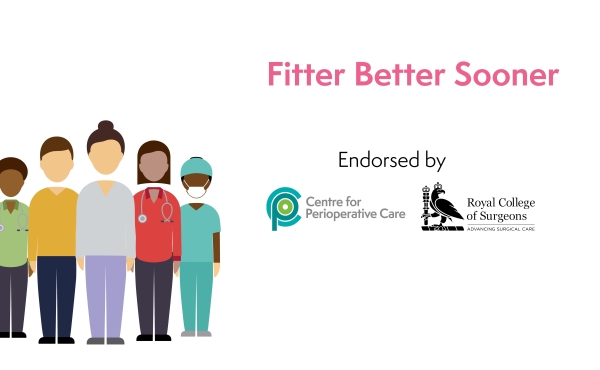Fitter Better Sooner - helping patients recover from surgery more quickly

Consultant Anaesthetist, Patient Information Lead for the Royal College of Anaesthetists

CPOC Deputy Director, Consultant Orthopedic Surgeon
Having surgery is a major event for most patients. Given the opportunity, most would want to optimise their chance of successful surgery and of an uneventful recovery period if there was not too much pain or hard work involved. Sadly in 2020 much elective work has been curtailed by Coronavirus. That does mean though that these patients are now likely to have longer to improve their activity levels and physical and mental health prior to surgery, so potentially an even greater impact on their recovery. Understanding the steps they can take can also empower patients to make lasting changes to their long term health.
Fitter, Better, Sooner is a toolkit aimed at helping patients to prepare physically and psychologically for surgery. It was produced by the patient information group at RCoA with representatives from the RCGP, RCSEng and patients on the working group, reflecting the importance of multidisciplinary input for optimal perioperative care. The resources have been endorsed by both the RCGP and RCSEng.
The toolkit is intended for patients who are awaiting, or considering, surgery. It introduces ways in which they can optimise their health, lifestyle and activity levels to maximise their chances of a good recovery, free of complications. It informs patients about the perioperative pathway, so they know what to expect and feel more in control which in turn reduces anxiety. It also deals with the practicalities of actively planning both for an admission to hospital and for their recovery at home.
The toolkit comprises :
- An electronic leaflet
- An animation for showing on screens in waiting rooms or on portable electronic devices
- Six procedure-specific leaflets covering some of the most common operations in the UK (cataract surgery, hysteroscopy, cystoscopy, hernia, knee arthroscopy and total knee replacement.)
The resources can be viewed on this link.
Before the pandemic the animation was shown on large screens in waiting rooms in many preassessment clinics – a really good way of engaging with patients whilst they wait. With the move to telephone consultations, many patients are no longer seeing this and preassessment staff have to focus more on the essential paperwork to complete. The ideal would be that patients access this information at a much earlier stage of their patient journey. Feedback from preassessment staff has been that, despite the relatively short timescale, some patients have been able to start making real changes to their activity and nutrition and that it has been something really helpful to have a positive to focus on.
Supporting patients to improve their chances of a good surgical outcome
The most common complications after surgery include wound complications and infections (surgical site and pulmonary). There is a clear relationship between poor cardiorespiratory fitness and developing postoperative complications. There is now good evidence on the impact of an increase in physical activity levels preoperatively on recovery from surgery.
Not all patients will be able to do this but we know the gains are greatest with modest increases in physical activity. Maintaining alcohol consumption within recommended limits improves wound healing.
Smoking cessation can reduce several perioperative complications by 50% including, cardiac, respiratory, wound and infectious adverse events. Preoperative anaemia is associated with both short-term morbidity and mortality after major surgery, and also an increased risk of blood transfusion, which is associated with poorer long term outcomes in cancer surgery. Poorly controlled diabetes (for example a pre-operative HbA1C >65mmol/l or 8.5%) is associated with postoperative complications including wound complications and infections.
Working together to improve patient outcomes
CPOC is the ideal organisation to share such resources and highlight these key messages to member organisations. It is in the interests of all members of the perioperative team to have informed, motivated and empowered patients. By providing information and resources as early as the point of referral for surgery or during initial discussions with GPs, we can maximise the use of time available for optimisation, particularly for those who have long waits for surgery.
How could GPs and surgeons use these resources in their surgeries?
Although anaesthetists and preassessment nurses are already successfully using these resources in preassessment clinics, there may be little information for patients to read in GP surgeries or surgical outpatient clinics on preoperative optimisation. When life returns to ‘normal’ post COVID, surgeries and outpatients could display the leaflets or play the Fitter, Better, Sooner animation as a rolling loop on screens in waiting areas. The toolkit also offers a range of posters, flyers and stickers to signpost the resources to patients. Many patients will merely need these resources signposting by a respected nurse, GP or surgeon. The latter can be done now electronically.
We must recognise the vital role that relatives and carers play in the perioperative journey and the importance of sharing these resources with them as well. This will help them understand the patient journey and equip them to provide practical and psychological support to their loved ones along the care pathway.
View the extensive range of patient information resources produced by RCoA
The Patient Information Group (PIG) has developed high quality resources for patients across the breadth of anaesthetic practice. These were certified by the PIF Trusted Information Creator Kitemark in 2020 – the new quality standard for patient information.
You and Your anaesthetic is our flagship resource detailing anaesthesia and the perioperative pathway. It is widely used in leaflet form in preassessment clinics and sign posts our other resources available electronically. Anaesthesia Explained is an online resource that explains anaesthesia and the perioperative pathway in far more depth. There are resources that explain procedures such as nerve blocks, anaesthesia that is subspecialty specific such as anaesthesia for vascular and ophthalmic surgery as well as information for certain patients such as those patients with obesity. We have detailed FAQs, a glossary of anaesthetic and medical terms, an easy read resource, fact sheets for rarer conditions directly affected by anaesthesia and a popular range of paediatric resources.
Following recent GMC guidance, we are required to support shared decision making and consent as fundamentals of our good practice. The Montgomery ruling means our patients need to be informed of the risks particularly relevant to their lives when consenting for procedures. High quality patient information is therefore of ever increasing importance. We have a very popular risk infographic that summarises risk from anaesthesia in a way that is easy for most to access and sign posts the 15 individual risk leaflets for those wanting to read more on a subject.
Lastly, we recognise the importance of access to high quality information for all. We have currently translated our 4 most popular resources into the 20 most used languages UK - including Welsh. Many others will be uploaded as they become available in the next six months.


